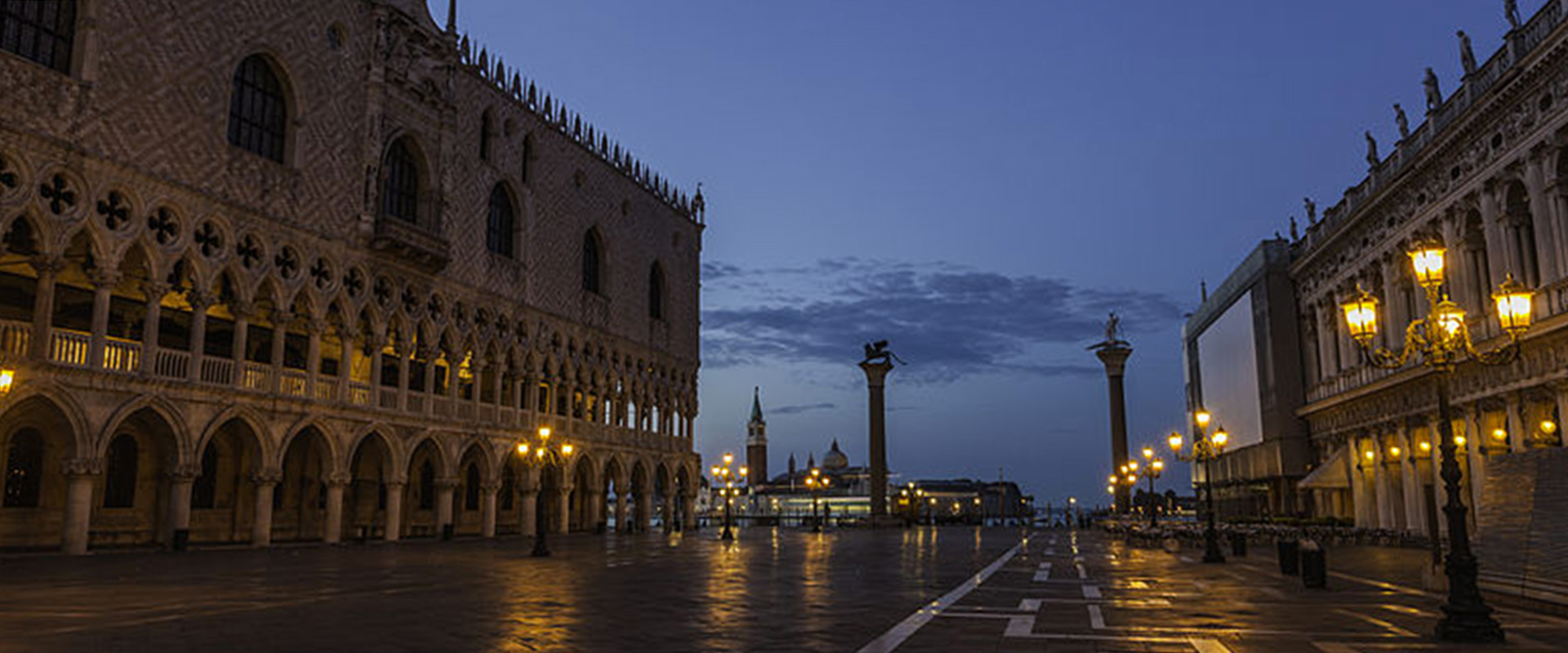Saint Mark’s Square is located in Venice and represents one of the most important Italian squares. It is renowned worldwide for its beauty and architectural integrity, being the largest square in Venice. It is the unique urban area in the city that is named ‘Piazza’, since all the other spaces with its shape are properly defined ‘Campi’. Its trapezoidal-shaped main body is 170 metres long: on it are added other areas. It is also known as ‘the Square ‘ or ‘ the drawing room of Europe’. The square itself (with reference to the area enclosed between the Procuratie Vecchie and Nuove and the ‘Nuovissime’) presents an architectural development of rare charm on the monumental complex of the basilica and just opposite, soaring, Saint Mark’s campanile (Bell Tower). The Basilica looks on the square with a marble façade dating back to the 13th century, in which were placed mosaics, bass reliefs and an abundance of bare heterogeneous material. This works gave the characteristic polychromy to the basilica, which is combined with the complex chiaroscuro effect due to the multifaceted openings and volumes. The two entrance doors at the far end (the southern one, dedicated to Saint Clement, dating back to the 11th century and the middle one to the 12th century) were built with Arabic-inspired inflected arched gables, maybe wanted to remember Alexandria in Egypt, where the martyrdom of Saint Mark took place.
The minor doors were realized later, with an antique taste. The only original mosaic of the façade is the one placed above the first portal on the left; the others are dated back to the 17th and 19th century and imitate the subjects of those that they replaced. Between the Piazzetta dei Leoni and the Procuratie lies the so-called ‘Torre dell’orologio’ (Clock tower), completed in 1499, which marks the beginning of the ‘Merceria’, a street along which are located the main shops of the city. Through a porch, it represents the ground access to the square. The small San Basso church (attached on the right side of the square), was deconsecrated. It was designed by Baldassare Longhena and used for exhibitions. On the west side of the square, you can find the Procuratie Vecchie, official Headquarters of Saint Mark’s attorneys during the Serenissima. They were built in the early part of the sixteenth century. The arcade on the ground floor is full of shops and restaurants, and even today the upper floors host several offices. Under these arches there is the famous Caffe’ Quadri, founded in 1755 and opposed to the Caffé Florian, located on the other side of the square.
At the end of the square there is the so-called Napoleonic wing, which connects the Procuratie Vecchie with the new ones: takes this name from the fact that it was rebuilt in 1810 through the will of Napoleon. It had been originally designed as a representative office, and now it hosts the Correr Museum. In front of the Procuratie Vecchie are located the Procuratie Nuove: designed by Jacopo Sansovino in the 16th century, they needed to be restored between 1582 and 1586. The refurbishment was managed first by Vincenzo Scamozzi and after by Baldassare Longhena, which closed the work site around 1640. As for the procuratie facing one another, the arcade on the ground floor houses different kind of shops, above all the Caffe’ Florian, initially known as ‘To the triumphant Venice’, meeting place of the Venetian people during the fights against the Austrian domination. According to Napoleon, the palace should have become Eugène de Beauharnais headquarters. The eastern end of this building is occupied by the Libreria Marciana, designed by Sansovino, which overlooks the square. Near the point of contact between these two massive buildings is located the Saint Mark’s campanile, built between 1156 and 1173 in an early form, restored in 1514 and rebuilt without modifications in 1902 after the collapse. Near the Bell Tower, in line with Porta della Carta (monumental entrance of the Doge’s Palace), there is a loggia, designed by Sansovino and built between 1537 and 1546.
